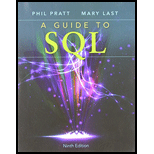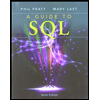
A Guide to SQL
9th Edition
ISBN: 9781111527273
Author: Philip J. Pratt
Publisher: Course Technology Ptr
expand_more
expand_more
format_list_bulleted
Concept explainers
Question
Chapter 4, Problem 21TD
Program Plan Intro
“SELECT” command:
The “SELECT” command is used to retrieve data in a
Syntax for selecting values from the table is as follows:
SELECT STUDENT_ID FROM STUDENT;
- The given query is used to display each student ID from “STUDENT” table.
NULL:
- Sometimes a condition occupies a column that can allow null values.
- To find rows in which a particular column contain a null value, then the SQL uses “IS NULL” operator.
- If it does not contain a null value, then the SQL uses “IS NOT NULL” operator.
Example:
The example for using “IS NULL” operator is given below:
SELECT STUDENT_ID, STUDENT_NAME FROM STUDENT WHERE STREET IS NULL;
The above query is used for selecting rows containing null values in the “STREET” column.
Expert Solution & Answer
Trending nowThis is a popular solution!

Students have asked these similar questions
Assignment Instructions:
You are tasked with developing a program to use city data from an online database and generate a
city details report.
1) Create a new Project in Eclipse called "HW7".
2) Create a class "City.java" in the project and implement the UML diagram shown below and add
comments to your program.
3) The logic for the method "getCityCategory" of City Class is below:
a. If the population of a city is greater than 10000000, then the method returns "MEGA"
b. If the population of a city is greater than 1000000 and less than 10000000, then the
method returns "LARGE"
c. If the population of a city is greater than 100000 and less than 1000000, then the method
returns "MEDIUM"
d. If the population of a city is below 100000, then the method returns "SMALL"
4) You should create another new Java program inside the project. Name the program as
"xxxx_program.java”, where xxxx is your Kean username.
3) Implement the following methods inside the xxxx_program program
The main method…
CPS 2231 - Computer Programming – Spring 2025
City Report Application
-
Due Date:
Concepts: Classes and Objects, Reading from a file and generating report
Point value: 40 points.
The purpose of this project is to give students exposure to object-oriented design and programming
using classes in a realistic application that involves arrays of objects and generating reports.
Assignment Instructions:
You are tasked with developing a program to use city data from an online database and generate a
city details report.
1) Create a new Project in Eclipse called "HW7”.
2) Create a class "City.java" in the project and implement the UML diagram shown below and add
comments to your program.
3) The logic for the method "getCityCategory" of City Class is below:
a. If the population of a city is greater than 10000000, then the method returns "MEGA"
b. If the population of a city is greater than 1000000 and less than 10000000, then the
method returns "LARGE"
c. If the population of a city is greater…
Please calculate the average best-case IPC attainable on this code with a 2-wide, in-order, superscalar machine:
ADD X1, X2, X3
SUB X3, X1, 0x100
ORR X9, X10, X11
ADD X11, X3, X2
SUB X9, X1, X3
ADD X1, X2, X3
AND X3, X1, X9
ORR X1, X11, X9
SUB X13, X14, X15
ADD X16, X13, X14
Chapter 4 Solutions
A Guide to SQL
Ch. 4 - Prob. 1RQCh. 4 - Prob. 2RQCh. 4 - Prob. 3RQCh. 4 - Prob. 4RQCh. 4 - Prob. 5RQCh. 4 - In which clause would you use a wildcard in a...Ch. 4 - Prob. 7RQCh. 4 - How do you determine whether a column contains one...Ch. 4 - Prob. 9RQCh. 4 - Prob. 10RQ
Ch. 4 - Prob. 11RQCh. 4 - Prob. 12RQCh. 4 - Prob. 13RQCh. 4 - Prob. 14RQCh. 4 - Prob. 15RQCh. 4 - Prob. 16RQCh. 4 - How do you find rows in which a particular column...Ch. 4 - Use the Internet to research the SQL [charlist]...Ch. 4 - Prob. 1TDCh. 4 - Prob. 2TDCh. 4 - Prob. 3TDCh. 4 - Prob. 4TDCh. 4 - Prob. 5TDCh. 4 - Prob. 6TDCh. 4 - Prob. 7TDCh. 4 - Prob. 8TDCh. 4 - Prob. 9TDCh. 4 - Prob. 10TDCh. 4 - Prob. 11TDCh. 4 - Prob. 12TDCh. 4 - Prob. 13TDCh. 4 - Prob. 14TDCh. 4 - Prob. 15TDCh. 4 - Prob. 16TDCh. 4 - What is the price of the least expensive item in...Ch. 4 - Prob. 18TDCh. 4 - Prob. 19TDCh. 4 - Prob. 20TDCh. 4 - Prob. 21TDCh. 4 - Prob. 22TDCh. 4 - Prob. 23TDCh. 4 - Prob. 1CATCh. 4 - Prob. 2CATCh. 4 - Prob. 3CATCh. 4 - Prob. 4CATCh. 4 - Prob. 5CATCh. 4 - Prob. 6CATCh. 4 - Prob. 7CATCh. 4 - Prob. 8CATCh. 4 - Prob. 9CATCh. 4 - Prob. 10CATCh. 4 - Prob. 11CATCh. 4 - Prob. 12CATCh. 4 - Prob. 13CATCh. 4 - Prob. 14CATCh. 4 - Prob. 15CATCh. 4 - Prob. 16CATCh. 4 - Prob. 17CATCh. 4 - Prob. 18CATCh. 4 - Prob. 19CATCh. 4 - List the reservation ID and trip ID for all trips...Ch. 4 - Prob. 1SCGCh. 4 - Prob. 2SCGCh. 4 - Prob. 3SCGCh. 4 - Prob. 4SCGCh. 4 - Prob. 5SCGCh. 4 - Prob. 6SCGCh. 4 - Prob. 7SCGCh. 4 - Prob. 8SCGCh. 4 - Prob. 9SCGCh. 4 - Prob. 10SCGCh. 4 - Prob. 11SCGCh. 4 - Prob. 12SCGCh. 4 - Prob. 13SCGCh. 4 - Prob. 14SCGCh. 4 - Prob. 15SCGCh. 4 - Prob. 16SCG
Knowledge Booster
Learn more about
Need a deep-dive on the concept behind this application? Look no further. Learn more about this topic, computer-science and related others by exploring similar questions and additional content below.Similar questions
- Outline the overall steps for configuring and securing Linux servers Consider and describe how a mixed Operating System environment will affect what you have to do to protect the company assets Describe at least three technologies that will help to protect CIA of data on Linux systemsarrow_forwardNode.js, Express, Nunjucks, MongoDB, and Mongoose There are a couple of programs similar to this assignment given in the lecture notes for the week that discusses CRUD operations. Specifically, the Admin example and the CIT301 example both have index.js code and nunjucks code similar to this assignment. You may find some of the other example programs useful as well. It would ultimately save you time if you have already studied these programs before giving this assignment a shot. Either way, hopefully you'll start early and you've kept to the schedule in terms of reading the lecture notes. You will need to create a database named travel using compass, then create a collection named trips. Use these names; your code must work with my database. The trips documents should then be imported unto the trips collection by importing the JSON file containing all the data as linked below. The file itself is named trips.json, and is available on the course website in the same folder as this…arrow_forwardusing r languagearrow_forward
- using r languagearrow_forwardusing r languagearrow_forwardWrite a short paper (1 page/about 500 words) summarizing what we as System Admins can do to protect the CIA of our servers. Outline the overall steps for configuring and securing Linux servers Consider and describe how a mixed Operating System environment will affect what you have to do to protect the company assets Describe at least three technologies that will help to protect CIA of data on Linux systems Required Resourcesarrow_forward
- using r language Estimate the MSE of the level k trimmed means for random samples of size 20 generated from a standard Cauchy distribution. (The target parameter θis the center or median; the expected value does not exist.) Summarize the estimates of MSE in a table for k= 1,2,...,9arrow_forwardusing r language Estimate the MSE of the level k trimmed means for random samples of size 20 generated from a standard Cauchy distribution. (The target parameter θis the center or median; the expected value does not exist.) Summarize the estimates of MSE in a table for k= 1,2,...,9arrow_forwardusing r language The data law82 in bootstrap library contains LSAT and GPA for 82 law schools. Compute a 95% bootstrap t confidence interval estimates for the correlation statisticsarrow_forward
- using r language The data law82 in bootstrap library contains LSAT and GPA for 82 law schools. Compute a 95% bootstrap t confidence interval estimates for the correlation statisticsarrow_forwardusing r langauge The data law82 in bootstrap library contains LSAT and GPA for 82 law schools. Compute and compare the three 95% bootstrap confidence interval estimates for the correlation statistics.arrow_forwardWhat is the number of derangements of size k from the set {1,2,...n} to the set {1,2,...n} so that f(x) != x exactly k times with 1 <= k <= narrow_forward
arrow_back_ios
SEE MORE QUESTIONS
arrow_forward_ios
Recommended textbooks for you

 A Guide to SQLComputer ScienceISBN:9781111527273Author:Philip J. PrattPublisher:Course Technology PtrNp Ms Office 365/Excel 2016 I NtermedComputer ScienceISBN:9781337508841Author:CareyPublisher:Cengage
A Guide to SQLComputer ScienceISBN:9781111527273Author:Philip J. PrattPublisher:Course Technology PtrNp Ms Office 365/Excel 2016 I NtermedComputer ScienceISBN:9781337508841Author:CareyPublisher:Cengage


A Guide to SQL
Computer Science
ISBN:9781111527273
Author:Philip J. Pratt
Publisher:Course Technology Ptr

Np Ms Office 365/Excel 2016 I Ntermed
Computer Science
ISBN:9781337508841
Author:Carey
Publisher:Cengage